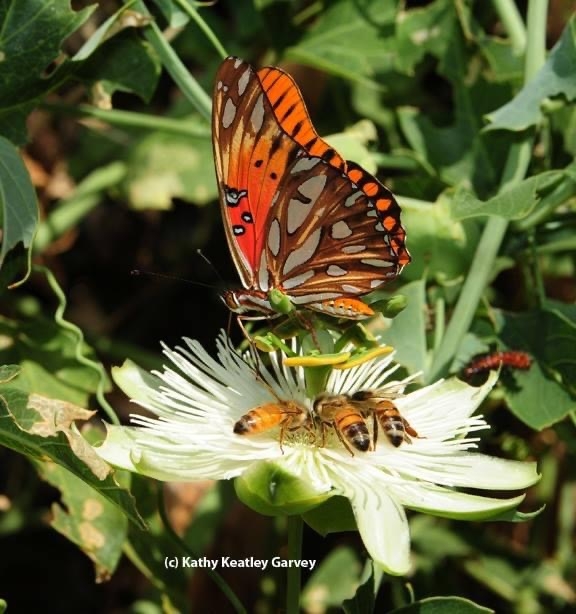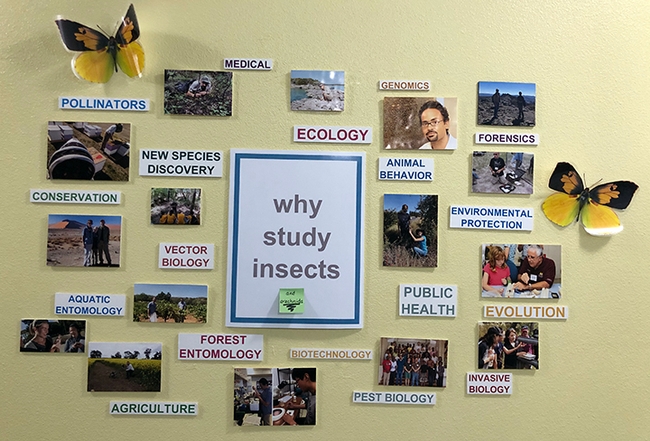That's the title of a poster next to the door of the Bohart Museum of Entomology, located in Room 1124 of the Academic Surge Building, 455 Crocker Lane, UC Davis.
The poster specifies possible careers, listing pollinators, medical, genomics, animal behavior, forensics, environmental protection, public health, evolution, pest biology, invasive biology, pest biology, biotechnology, forest entomology, agriculture, aquatic entomology, vector biology, conservation and new species discovery.
Images of California's state insect, the California dogface butterfly, Zerene eurydice, decorate the poster. The butterfly is also the featured insect in the Bohart Museum's logo.
Not to be left out, someone from the nearby laboratory of arachnologist Jason Bond added to the "Why Study Insects" poster: "Arachnids!" Yes, let's study arachnids, too! Bond is the Evert and Marion Schlinger Endowed Chair, UC Davis Department of Entomology and Nematology, and associate dean, UC Davis College of Agricultural and Environmental Sciences. And he's the president-elect of the American Arachnological Society. (See news story)
The Entomological Society of America (ESA) defines entomology as the study of insects. "Entomologists study bees, ants, beetles, termites, mosquitoes, and other insects, as well as other related animals (known as arthropods), such as spiders and scorpions...While it has been estimated that there are as many as 30 million species of insects on the planet Earth, only about one million have actually been discovered and described."
Another factoid from ESA: "Many animals, such as birds, fish, and snakes, eat insects, so they are an important part of the food chain. And without insect pollinators, global vegetation would largely collapse. At the same time, other insects are important decomposers — they eat dead plants and animals, which releases nutrients back into the soil so that new plants and animals can grow. Still other insects are parasites or predators, and they help control the populations of other species. Entomologists study insects and other animals in their habitats, which teaches us how to preserve and restore natural ecosystems."
How many insects are there in the world? According to the Smithsonian Institute, "there are some 10 quintillion (10,000,000,000,000,000,000) individual insects alive."
"In the United States, the number of described species is approximately 91,000," the Smithsonian says. "The undescribed species of insects in the United States, however, is estimated at some 73,000. The largest numbers of described species in the U.S. fall into four insect Orders: Coleoptera (beetles) at 23,700, Diptera (flies) at 19,600, Hymenoptera (ants, bees, wasps) at 17,500, and Lepidoptera (moths and butterflies) at 11,500."
"Recent figures indicate that there are more than 200 million insects for each human on the planet! A recent article in The New York Times claimed that the world holds 300 pounds of insects for every pound of humans."
Another factoid from the Smithsonian: "Most authorities agree that there are more insect species that have not been described (named by science) than there are insect species that have been previously named. Conservative estimates suggest that this figure is 2 million, but estimates extend to 30 million."
"While it has been estimated that there are as many as 30 million species of insects on the planet Earth, only about one million have actually been discovered and described."
So, we're not running out of insects any time soon!
The Bohart Museum of Entomology, directed by UC Davis distinguished professor Lynn Kimsey, houses a global collection of eight million insect specimens. It is part of the UC Davis Department of Entomology and Nematology, ranked as one of the nation's leading entomology departments. Department chair is Professor Joanna Chi, a molecular geneticist-physiologist. Vice chair is associate professor Rachel Vannette, a community ecologist.
Attached Images:

